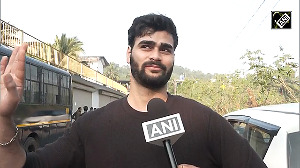What this seems to indicate is that whenever there is a sale of a painting in the secondary market, the artist, who holds the copyright on the work, should be paid up to 10 per cent of the price at which the work is sold, provided it is a value greater than Rs 10,000. It is another matter that this issue of legalese has never been put to test before a court of law in India.
If you will cast your mind back over the last years, when artists were establishing record prices at auction sales, you may well ask: Did they make any money from the secondary sales proceeds? The truth is that while most achieved stupendous value, gaining the artists a good deal of prestige, it earned them absolutely no revenue zero, zilch, nothing.
No gallery, or auction house, has gone on record to say it has made a payment on a secondary sale to the artist in question. How did a Tyeb Mehta, an S H Raza, or the estate managers of F N Souza gain from the record-breaking auctions of their earlier works, which must have originally sold for a few thousand rupees, but which are now valued for at least as many crores?
This may have as much to do with the professional art fraternity not knowing about the copyright act as wanting to block it for once the Pandoras box of resale rights is opened, it will find huge applicability and make professional intermediaries art galleries, auction houses or dealers accountable for the bureaucratese of monitoring payments of such resale rights.
But who will actually make the payment the new owner, the old owner, the auctioneer, or the gallerist who facilitated the sale? It is clear that factors such as these require discussion (and consensus), as everyone will try to pass the buck, though the EU directive on resale rights suggests that royalty should be paid by the seller.
Earlier this year, a Parliamentary Committee in Australia backed the introduction of a 5 per cent resale royalty scheme for its artists. Largely instrumental in clearing the legislation was the debate surrounding a painting by Australian aboriginal artist Clifford Possum Tjapaltjarri who had received, in 1977, $1200 for his work Warlugulong, auctioned three decades later for $2.4 million by Sothebys, none of which found its way to the artists estate.
Australia has based its resale rights based on what it has observed in France and Germany, and taking into account European Union directives for all visual arts pictures, collages, drawings, engravings, prints, lithographs, sculptures, photographs, tapestries and including all professional art intermediaries, the rights themselves largely based on a flat rate between 3 and 5 per cent.
But what the European Union, and more recently Australia, are establishing, is already law in India, though its interpretation now needs to be put to the test.
Obviously, it will require the services of a collecting, or monitoring, agency: Owners of artworks may have to submit lists to relevant authorities, in itself an arduous task given that people buy art (in its loosest sense) frequently, and if every pichwai or Tanjore painting or Ganesh idol sold and resold will require paperwork, the scheme is doomed to be a non-starter. Perhaps the solution, like the EU, is to have a sliding scale of payment based on a minimum secondary sale value of E1000.
To oversee collecting and licencing issues, agencies such as Viscopy funded by the Commonwealth have proved useful in some countries, and may be required in India. But before that happens, Indian artists will have to take upon themselves the onus of demanding resale fees as a matter of course.
And that's one battle in which they will get no help from the professional intermediaries to begin with at least.






